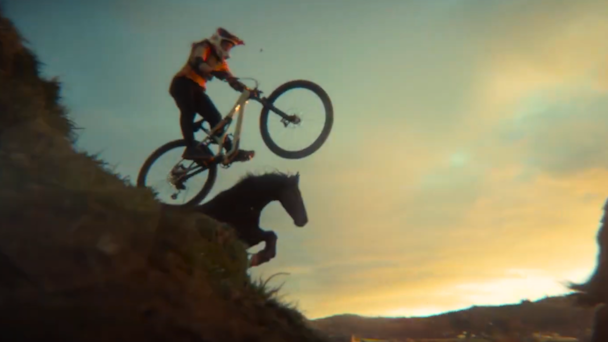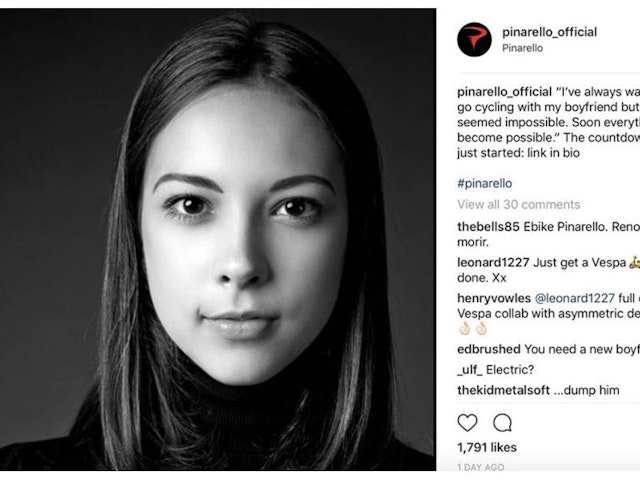Why empowering women to cycle is a wheelie great idea for brands
Advertising strategist Jo Costello believes that brands are missing a huge opportunity and social good in driving more women into cycling. It worked for her, and it can work for more.

When I was a little girl, I used to cycle in circles around the garden, changing the channels on my imaginary radio. I did this for hours. Voluntarily. I just loved riding my bike. Then I grew up. And forgot about it. Until 2022, during the pandemic, I bought a single-speed bike, and terrified, I hugged the curb like a newborn hugs its mother. I suddenly loved cycling again, so much so that a friend nicknamed me Sir Bradley.
But the single-speed was merely a gateway.
I upgraded to a road bike a year later. I was too scared to ride outside of London, so I joined Islington Cycling Club to build confidence, convinced I’d arrive to find muscle-laden, Lycra-clad men wearing time trial helmets who’d sneer at my lack of cleats and self-belief. In reality, I met some nice people and went on to cycle 3,900 miles over 10 months, 450 of which were ridden in the quad-crushing lands of Tenerife.
I got the most out of cycling only when I started riding with others.
I’d see the Strava uploads of women I’d met and think, “I wonder if I can do that.” I once found myself in a deep 1am texting conversation with a woman from my club… dissecting the data from my new power meter. I found friendship, community, and a never-ending supply of challenges.
Advertisement
I wish I had started cycling sooner.
But I didn’t know of any female cyclists, and I didn’t see cycling as a sport for me. This isn’t surprising, considering the stereotypical cyclist is a ‘middle-aged man in Lycra.’
It’s no wonder the UK government found that men make three times as many cycling trips as women. British Cycling memberships skew 80% male. Swains Lane, the toughest hill in London, has been conquered by 28,700 men but only 3,400 women (I place a modest 101). Remarkably, 90% of British women don’t even own a bike (Bott & Co).
So the big question is, how many other girls and women like me harbor an undiscovered love of cycling? Bott and Co found that almost half of UK women want to take up cycling. The UK has 30.4 million women and girls (2021 Census). So, potentially, a lot.
Advertisement
Recently, we’ve witnessed women’s football catapult into the mainstream. Women’s football is predicted to be worth £500m by 2033 (UEFA). More importantly, 100,000 more British girls are playing it (Sport England). Yet, improvements remain in how the sport can be marketed.
The University of Birmingham found links between girls who play football and confidence, self-esteem, and the development of essential life skills. The community sport gives them access to a ‘second family.’ It is similar to the benefits I got from cycling. Unlike football, cycling doesn’t get much attention from brands. Considering women’s cycling is booming, this is perplexing. With its record viewing figures, the Tour de France Femmes alone is changing the face of women’s cycling. But there is work to be done.
Let’s explore how underrepresentation, misogyny, and safety concerns are steering women away from the pedals. And how brands can help more women discover the endless joys of cycling.
Shift gears on your branding and get girls cycling
“I’d love for this [Lloyds Bank] advert to be the spark that kindles the love of mountain biking for some girls,” said Nina Cameron, downhill racer.
They say you never forget how to ride a bike. But you can forget how to feel carefree while doing so. Getting back on a bike after many years off was intimidating. I was convinced people were seeing me for the fraudulent cyclist I felt I was. I wasn’t alone. Many women found it daunting to get back on the saddle. What was second nature as a child became a war with the mind as an adult.
This isn’t surprising when you consider the reasons girls stop playing sports in the first place. Sport England found that 68% of teenage girls cited fear of judgment as preventing them from participating in sports, and 61% cited a lack of confidence. “Worryingly, girls lose their love of sport and exercise during teenage years, and this presents a significant psychological barrier throughout life,” the 2022 report said.
Suggested newsletters for you
There is good news. Female role models encourage more girls to play sports (Stormont Academy). Women who played sports at school are 76% more likely to stay interested forever (Women And Sport). If we gave girls enough access to the sport they love, they may never fall out of love with it. But mass representation of women’s cycling is low.
Lloyds Bank is one of the few major brands that has brought female mountain bikers to the big screen. It integrated British mountain bikers Katy Curd and Nina Cameron into its ‘Bike’ campaign, which promoted their Smart Start Account for 11-15-year-olds. Lloyds Bank drew parallels between the confidence built when learning a sport and learning about finances at an early age – both equip children to be competent in these areas when they’re adults.
This ad is a brilliant start. It demonstrates how a brand’s purpose, being by the side of people and businesses, and the benefits of their product can be brought to life through women’s cycling. It gives parents mental access to consider mountain biking as an option for their daughters and gives girls cycling role models.
Even better would be brands showing how getting into cycling or any sport instills confidence that lasts as the girl becomes a woman. A campaign encouraging girls to continue with sports despite concerns over judgment would help prevent the psychological barrier that I and other women formed, keeping them emboldened for longer.
The only thing we’re dropping on this ride is sexism
“To see a woman on a bike is ugly,” said French professional road cyclist Marc Madiot in 1986. “I’m against women cycling.”
Islington Cycling Club (ICC) organizes rides in speed bands. Despite this, I still feel uneasy when I discover I’m the only woman on a bike ride with seven men. What if I’m too slow? The unease dissipates quickly but returns the next time I join a male-heavy ride.
ICC hosts dedicated women-only rides, and we have a separate WhatsApp community. I asked these women what they wished they could change about women’s cycling, and they said the comparison between men and women that women’s cycling is inferior, that women cannot, and don’t want to, go as fast as men. Recently, a male race director infamously called female pro cyclists “spoiled children,” and a newspaper refused to mention pro cyclist Urška Žigart by her name, referring to her only as “Tadej Pogačar’s girlfriend.”
While Nike, Orange, and EE have effectively challenged misogyny in women’s football, we are still waiting for this campaign in women’s cycling. It doesn’t help when esteemed cycling brands are accused of reinforcing negative stereotypes.
Pinarello unintentionally fell into hot oil when its Instagram post advertising a new e-bike range to women told them they could “finally” keep up with their boyfriends.

Negative perceptions of women’s cycling stem back to the Victorian era.
Doctors warned women against using the newfound contraption for fear of developing a “wearied and exhausted ‘bicycle face.’” Long-time cycling sponsor Skoda turned ‘Bicycle Face’ from a negative to a positive. It built a social campaign around the myth to celebrate women’s achievements in cycling despite the societal barriers they’ve faced. ‘Bicycle Face,’ a series of photos, celebrated the grit, determination, and relief on female cyclists’ faces as they raced. The series showed the camaraderie between the women, hugging as they reached the finish line.
Skoda remains one of the few major brands that have tackled misogyny in women’s cycling. Tackling deep-rooted stereotypes would open the floor up to a wave of new female cyclists who will reap the physical, mental, and social benefits of cycling.
Break the cycle of driver harassment.
“Drivers are afraid cyclists will slow them down. Cyclists are afraid drivers will kill them” … me.
When I began scooting around London on my single-speed, the slightest toot of a horn would send me bunny-hopping on to the curb. But no more. Road cycling helps you develop resilience, assertiveness, and confidence.
A “punishment pass” is when a driver purposefully overtakes you closely at speed. Though rare, I’ve gotten used to them now and hardly react. But they’ll be enough to put some women off.
Women are already cautious about cycling, with 41% saying they’re nervous about cycling in traffic, compared with 21% of men. What a shame, then, that drivers are 3.8 times more likely to pass women closely than men (University of Minnesota). Astounding new research from the London Cycling Campaign reported that 93% of women cyclists said drivers had used their vehicles to intimidate them. Unsurprisingly, one-fifth of women have given up cycling as a result.
Nothing tells a more compelling story than the 56% increase in women cyclists, compared with a 12% rise in men, during the car-free roads of 2020 (Department for Transport). Women like cycling; they just don’t like driver behavior. It begs the question if the drivers are aware of their actions.
Since I began road cycling, I’ve believed if a driver spent just one day as a cyclist, they would forever change their driving behavior. Ford recognized this insight and created WheelSwap, a VR tool that allows drivers to see from a cyclist’s point of view and vice versa. WheelSwap reached 63 million people. It convinced 91% of drivers and cyclists to change their behavior.
While WheelSwap has proven effective to wearers, its reliance on VR limits reach. Compelling campaigns from The New Zealand Transport Agency, Think!, and Transport Accident Commission have shown us creative executions can impact road safety. But what’s missing is one tailored to drivers’ abuse of women cyclists.
Whereas lacking representation and misogyny may prevent some women from picking up a bike in the first place, driver behavior is putting off the ones who already have. This needs to change. A creative campaign that jolts drivers out of their reckless driving inertia could be ground-breaking for women’s cycling. How can we make drivers empathize and see the incredible benefits of cycling that they’re robbing women of?
Pedal through the finish line to brand fame
Nothing has done more for my physical or mental health in the last few years than cycling has. Buying a £260 single-speed from Hackney Cycles unearthed a passion for road cycling that I went too long without knowing I had. From road cycling, I discovered track. I’m not interested in mountain, BMX, or gravel, but I know plenty of women who are. Many women already know they love cycling. Many don’t know they do yet.
Just as women across the country are starting initiatives and clubs to empower other women to get into cycling, brands can play a pivotal role in expediting the benefits of the sport to girls and women. Women’s cycling offers brands a rare opportunity to harness a booming yet unclaimed movement. Women’s cycling is rich with opportunities to execute ground-breaking campaigns – whether that’s representing the underrepresented, tackling deep-rooted misogyny, or breaking the cycle of driver harassment. Whichever social barrier you choose to shatter, the benefits of investing in women’s cycling for both people and brands are undeniable.
Check out The Drum’s International Women’s Day coverage here.

